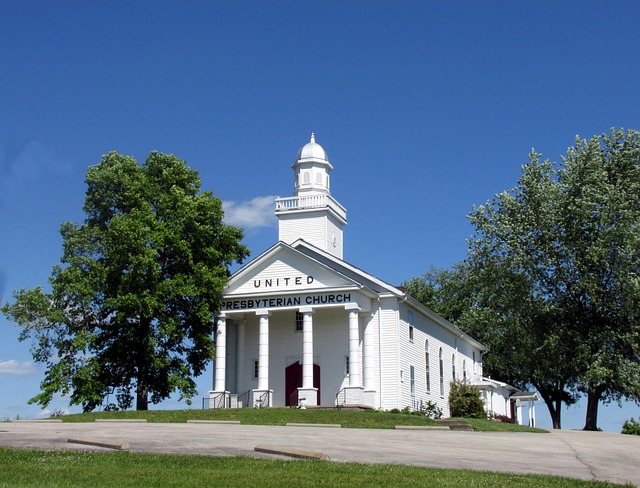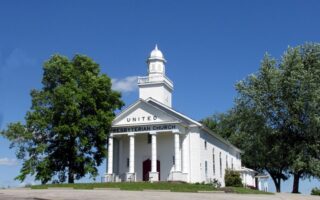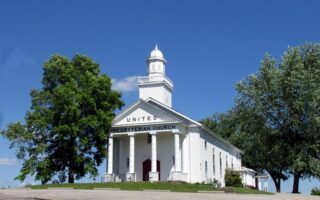There are two main types of Presbyterian churches: the Presbyterian Church (USA) and the Presbyterian Church in America.
Table of Contents
The Origins and Beliefs of the Presbyterian Church USA
The Presbyterian Church USA is one of the largest Protestant denominations in the United States. It has a rich history and a strong presence in many communities across the country. But what exactly is the Presbyterian Church USA, and what are its beliefs? In this article, we will explore the origins and beliefs of the Presbyterian Church USA.
The Presbyterian Church USA traces its roots back to the Protestant Reformation in the 16th century. It was influenced by the teachings of John Calvin, a French theologian who played a significant role in shaping the Reformed tradition. Calvin’s ideas emphasized the sovereignty of God and the authority of Scripture. These principles continue to be central to the beliefs of the Presbyterian Church USA.
One of the key beliefs of the Presbyterian Church USA is the concept of predestination. This is the idea that God has already determined who will be saved and who will not. While this may seem like a controversial belief, Presbyterians see it as a way to emphasize God’s sovereignty and grace. They believe that salvation is a gift from God and cannot be earned through good works.
Another important belief of the Presbyterian Church USA is the importance of the community of believers. Presbyterians believe that the church is not just a building, but a gathering of people who are called to worship and serve God together. They believe in the priesthood of all believers, which means that every member of the church has a role to play in its ministry and mission.
The Presbyterian Church USA also places a strong emphasis on education and intellectual inquiry. They believe that faith and reason are not mutually exclusive, but can and should be integrated. They encourage their members to study the Bible and engage in theological reflection. This commitment to education has led to the establishment of many Presbyterian colleges and seminaries throughout the United States.
In terms of worship, the Presbyterian Church USA follows a liturgical tradition. This means that their worship services are structured and follow a set order. They typically include prayers, hymns, Scripture readings, and a sermon. The sacraments of baptism and the Lord’s Supper are also important elements of Presbyterian worship.
The Presbyterian Church USA is known for its commitment to social justice and advocacy. They believe that the church has a responsibility to work for the well-being of all people and to address issues of injustice and inequality. They have been involved in various social movements throughout history, including the civil rights movement and the fight against poverty.
In conclusion, the Presbyterian Church USA is a Protestant denomination with a rich history and strong beliefs. It traces its roots back to the Protestant Reformation and is influenced by the teachings of John Calvin. The Presbyterian Church USA believes in the sovereignty of God, the importance of the community of believers, and the integration of faith and reason. They follow a liturgical tradition in worship and are committed to social justice and advocacy. Whether you are a member of the Presbyterian Church USA or simply interested in learning more about it, understanding its origins and beliefs can provide valuable insight into this important denomination.
Understanding the Differences Between the Presbyterian Church in America (PCA) and the Presbyterian Church USA (PCUSA)

Presbyterianism is a branch of Protestant Christianity that originated in Scotland in the 16th century. Today, there are various Presbyterian denominations around the world, each with its own distinct beliefs and practices. In the United States, two of the most prominent Presbyterian denominations are the Presbyterian Church in America (PCA) and the Presbyterian Church USA (PCUSA). While both share a common heritage, there are significant differences between the two.
The PCA and the PCUSA differ in their theological beliefs and interpretations of scripture. The PCA is known for its conservative stance on theological issues, adhering closely to the teachings of the Bible. They believe in the inerrancy of scripture and hold to traditional Christian doctrines such as the Trinity, the deity of Christ, and salvation through faith alone. On the other hand, the PCUSA takes a more liberal approach to theology, embracing a wider range of interpretations and allowing for more diversity of belief within the denomination. They emphasize social justice and inclusivity, often taking progressive stances on issues such as LGBTQ+ rights and gender equality.
Another key difference between the PCA and the PCUSA lies in their governance structures. The PCA operates under a more centralized form of church government, known as presbyterian polity. This means that decisions are made by a hierarchy of governing bodies, including local sessions, regional presbyteries, and a national General Assembly. The PCUSA, on the other hand, has a more decentralized structure, with greater autonomy given to individual congregations. This allows for more local decision-making and flexibility in adapting to the needs of each congregation.
Worship styles also vary between the PCA and the PCUSA. The PCA tends to have a more traditional approach to worship, with a focus on liturgy, hymns, and reverence. Services often include elements such as confession of sin, prayers of intercession, and the reading of scripture. In contrast, the PCUSA embraces a wider range of worship styles, from traditional to contemporary. They may incorporate more modern music, multimedia presentations, and interactive elements to engage worshippers.
In terms of membership, the PCA and the PCUSA have different demographics. The PCA has a reputation for being more conservative and attracting members who prioritize doctrinal purity and traditional values. As a result, it tends to have a smaller but more committed membership base. The PCUSA, on the other hand, has a larger and more diverse membership, with a broader range of theological beliefs and social perspectives represented.
Despite these differences, it is important to note that both the PCA and the PCUSA are part of the wider Presbyterian family. They share a common heritage and are united in their commitment to following Christ. While they may have different emphases and approaches, both denominations seek to serve God and make a positive impact in their communities.
In conclusion, the PCA and the PCUSA are two distinct types of Presbyterian churches in the United States. They differ in their theological beliefs, governance structures, worship styles, and membership demographics. Understanding these differences can help individuals make informed decisions about which denomination aligns more closely with their own beliefs and values. Ultimately, both denominations are part of the rich tapestry of Presbyterianism, each contributing to the diverse expression of the Christian faith.
Exploring the Role of Elders and Governance in Presbyterian Churches
Presbyterian churches are a branch of Protestant Christianity that originated in Scotland in the 16th century. They are known for their unique form of church governance, which is characterized by the involvement of elders in decision-making processes. In this article, we will explore the role of elders and governance in Presbyterian churches, and discuss the two main types of Presbyterian churches.
One of the defining features of Presbyterian churches is the role of elders. These individuals are elected by the congregation and serve as spiritual leaders and decision-makers within the church. They are responsible for providing pastoral care, teaching, and guidance to the members of the congregation. Elders are also involved in the governance of the church, helping to make important decisions about matters such as worship, finances, and outreach.
The first type of Presbyterian church is known as the “sessional” or “session-governed” church. In this model, the governing body of the church is called the session, which is made up of the elders. The session is responsible for overseeing the spiritual and practical affairs of the church. They meet regularly to discuss and make decisions on various matters, such as the appointment of ministers, the administration of sacraments, and the management of church property. The sessional model emphasizes the authority and responsibility of the elders in leading the church.
The second type of Presbyterian church is known as the “congregational” or “congregationally governed” church. In this model, the ultimate authority rests with the congregation as a whole. While elders still play a significant role in the decision-making process, the congregation has the final say on important matters. This means that major decisions, such as the calling of a new minister or changes to the church’s constitution, must be approved by a vote of the congregation. The congregational model emphasizes the participation and voice of the entire congregation in the governance of the church.
Both types of Presbyterian churches have their own strengths and weaknesses. The sessional model allows for strong leadership and efficient decision-making, as the elders are able to act quickly and decisively. However, it can also lead to a lack of input from the congregation and a potential concentration of power in the hands of a few individuals. On the other hand, the congregational model ensures that the congregation has a say in important decisions and promotes a sense of ownership and community. However, it can also lead to lengthy decision-making processes and potential conflicts within the congregation.
In conclusion, the role of elders and governance in Presbyterian churches is a crucial aspect of their identity. The involvement of elders in decision-making processes ensures that the church is led by individuals who are committed to the spiritual well-being of the congregation. The two main types of Presbyterian churches, sessional and congregational, offer different approaches to governance, each with its own strengths and weaknesses. Ultimately, the choice between these models depends on the specific needs and values of the congregation.
Comparing the Worship Styles and Practices of Different Presbyterian Denominations
Presbyterianism is a branch of Protestant Christianity that originated in Scotland during the 16th century. Over time, it has spread to various parts of the world, including the United States. Today, there are several different Presbyterian denominations, each with its own unique worship styles and practices. In this article, we will explore the two main types of Presbyterian churches and compare their worship styles.
The first type of Presbyterian church is the traditional or conservative Presbyterian church. These churches tend to have a more formal and structured worship style. The order of worship is carefully planned and follows a set pattern. The service typically begins with a call to worship, followed by hymns and prayers. The congregation then listens to a sermon, which is often based on a specific Bible passage. The service concludes with a benediction and a closing hymn.
In traditional Presbyterian churches, the focus is on the Word of God. The sermon is considered the central part of the worship service, and it is given great importance. The sermons are usually expository in nature, meaning that they explain and interpret the meaning of a particular Bible passage. The goal is to help the congregation understand and apply the teachings of the Bible to their daily lives.
Another characteristic of traditional Presbyterian churches is the use of liturgy. Liturgy refers to a prescribed form of worship that includes specific prayers, readings, and responses. The liturgy helps to create a sense of unity and continuity within the congregation. It also emphasizes the historical and theological roots of the Presbyterian tradition.
On the other hand, there are also contemporary or progressive Presbyterian churches. These churches have a more relaxed and informal worship style. The order of worship is often more flexible and can vary from week to week. The music is usually more contemporary, with a mix of traditional hymns and modern worship songs. The sermon may be shorter and more interactive, with opportunities for discussion and reflection.
In contemporary Presbyterian churches, the focus is on creating a welcoming and inclusive environment. The goal is to engage the congregation and make them feel connected to the worship experience. These churches often incorporate multimedia elements, such as videos and slideshows, to enhance the worship service. They may also have more interactive elements, such as small group discussions or prayer stations.
While the worship styles may differ, both traditional and contemporary Presbyterian churches share a common commitment to the core beliefs of the Presbyterian tradition. These beliefs include the sovereignty of God, the authority of Scripture, and the importance of faith and grace. Both types of churches also emphasize the importance of community and service to others.
In conclusion, there are two main types of Presbyterian churches: traditional and contemporary. Traditional Presbyterian churches have a more formal and structured worship style, with an emphasis on the Word of God and the use of liturgy. Contemporary Presbyterian churches, on the other hand, have a more relaxed and informal worship style, with a focus on creating a welcoming and inclusive environment. Despite their differences in worship style, both types of churches share a common commitment to the core beliefs of the Presbyterian tradition.
Conclusion
The two types of Presbyterian churches are the Presbyterian Church (USA) and the Presbyterian Church in America (PCA).


